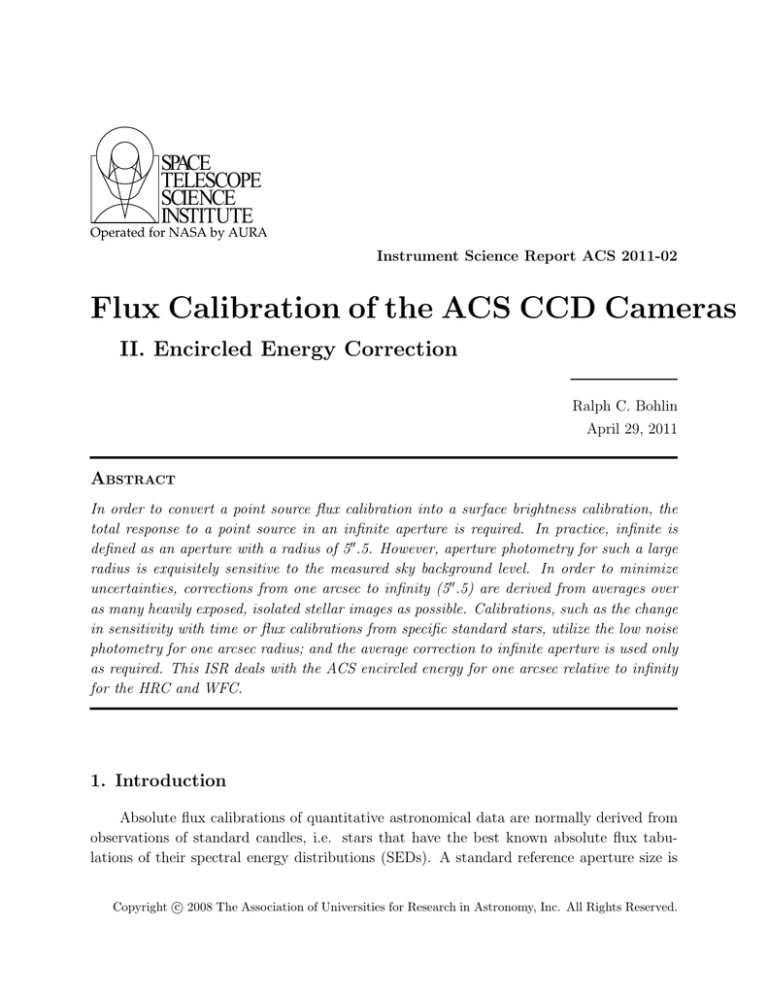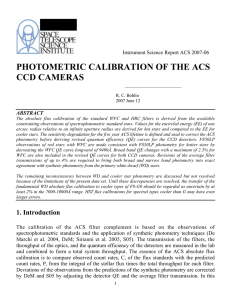
SPACE
TELESCOPE
SCIENCE
INSTITUTE
Operated for NASA by AURA
Instrument Science Report ACS 2011-02
Flux Calibration of the ACS CCD Cameras
II. Encircled Energy Correction
Ralph C. Bohlin
April 29, 2011
ABSTRACT
In order to convert a point source flux calibration into a surface brightness calibration, the
total response to a point source in an infinite aperture is required. In practice, infinite is
defined as an aperture with a radius of 5′′ .5. However, aperture photometry for such a large
radius is exquisitely sensitive to the measured sky background level. In order to minimize
uncertainties, corrections from one arcsec to infinity (5′′ .5) are derived from averages over
as many heavily exposed, isolated stellar images as possible. Calibrations, such as the change
in sensitivity with time or flux calibrations from specific standard stars, utilize the low noise
photometry for one arcsec radius; and the average correction to infinite aperture is used only
as required. This ISR deals with the ACS encircled energy for one arcsec relative to infinity
for the HRC and WFC.
1. Introduction
Absolute flux calibrations of quantitative astronomical data are normally derived from
observations of standard candles, i.e. stars that have the best known absolute flux tabulations of their spectral energy distributions (SEDs). A standard reference aperture size is
c 2008 The Association of Universities for Research in Astronomy, Inc. All Rights Reserved.
Copyright established for which the extraction of the observed signal is most repeatable, i.e. photometric, over the instrumental lifetime. Since the flux standards are bright stars, a large aperture
is chosen, which is a one arcsec radius for the ACS WFC and HRC channels. For crowded
field photometry, smaller apertures are required; and aperture corrections must be derived
relative to the fiducial one arcsec size. The smaller the extraction aperture, the greater the
dependence of the encircled energy fraction on focus and variability of focus across the field
of view.
Because standards of diffuse surface brightness are not well established around the sky,
the calibration in physical units of specific intensity for diffuse objects must be derived from
point sources and requires an estimate of the total signal from the standard star in an infinite
aperture. For the Equations and details of the flux and specific intensity calibrations for filter
photometry, see Bohlin, et al. (2011, hereafter B11). For the two ACS CCD channels, a
radius of 5′′ .5 is chosen to approximate infinity (Sirianni et al. 2005, hereafter S05; Bohlin
2007, hereafter B07). A theoretical check on the assumption that 5′′ .5 contains all of the
PSF is not possible with Tiny Tim, because the user manual states: “At short wavelengths,
it may not be possible to compute a PSF larger than 7′′ . Generally, the models are not
very good past a radius of ∼2′′ , due to the effects of scatter and high-frequency aberrations”
(Krist and Hook 2004).
This ISR is the second (II) in a four part series that will culminate with a new flux
calibration for the ACS CCD detectors. Based on the pixel level CTE correction technique
of Anderson & Bedin (2010), ISR I (Bohlin & Anderson 2011) defined the CTE losses for
observations of the bright standard stars with the WFC CCD. ISR III will deal with the
sensitivity changes over time. Here, the aperture corrections for photometry in a one arcsec
radius vs. an “infinite” (5′′ .5) radius are presented. The small Bohlin & Anderson CTE
corrections are applied to the 1′′ photometry; but all of the temporarily trapped charge is
assumed to be re-emitted and captured in an aperture as large as our (5′′ .5) radius.
2. Analysis of the Hot Star Data
Following de Marchi et al. (2004), Bohlin & Gilliland (2004, BG), S05, and B07, a 5′′ .5
photometric aperture is defined to contain all the signal from a stellar point source. Sky
backgrounds are defined in the annuli of 6-8′′ for WFC and 5.6-6′′.5 for HRC. Total stellar
signals are required to define the diffuse-source surface-brightness calibration and to compare with predicted count rates from the component throughput measurements. Aperture
photometry is computed with the IDL program apphot.pro (Landsman 2004 pers. comm.).
The apphot.pro photometry is verified against IRAF results, and photometry from the crj
2
files plus pixel area maps is equivalent to photometry from the drz files. For the WFC observations of the bright star BD+17◦4804 (BG), the f lt files must be used because of saturation
of the CCD in a few central pixels of the images. However, Gilliland (2004) demonstrated
the linearity of such saturated data to 0.1%, as long as the A-to-D converter does not saturate, i.e. gain=2 is required. For the 2009 WFC observations of BD+17◦ 4804, some of
the exposure times were increased from 1 to 2s, which occasionally causes a few saturated
pixels to fall outside the 1′′ aperture. A limit of ∼ 7 × 106 electrons in an individual image
corresponds to the onset of this excess saturation and is exceeded for the 2s exposures in
F606W, F625W, and F814W, which cannot be used in this analysis.
Table 1 summarizes the number of valid measurements by star, camera, and filter.
In addition to the ∼ 7 × 106 electron constraint, encircled energy (EE) measurements are
excluded if the sub-array size is less than 1024x1024, if the star is more than 4′′ for HRC or
8′′ .4 for WFC from the reference point, or if the sub-array lacks overscan data. The HRC
reference point is the center of the detector, while for WFC the standard WFC1-1K sub-array
is centered on chip 1 at (3583,1535). Individual EE values with large formal uncertainties
are also excluded from the averages.
Average EE values for the ten bright standard stars are displayed in Figures 1 and 2
as a function of the filter pivot wavelength. The 3σ error-in-the-mean for the average of
the four WDs plus the F, G, and K stars are shown as the error bars. Heavy black lines
are the polynomial fits to these averages for the seven hotter stars, i.e. cubic for WFC and
fourth order for HRC. The cool stars VB8 (M7), 2M0036+18 (L3.5), and 2M0559-14 (T5)
are excluded because of the scattered red-light problem for the long wavelength filters, as
discussed in §3. For the filters shortward of 7000Å, the fluxes for the cool stars drop steeply,
so that the count rates are relatively low and the exposure times corresponding longer, which
increases the effect of noise from cosmic-ray hits and hot pixels in the huge 5′′ .5 aperture.
Thus, all photometry with less than 16,000 counts/s for WFC and 10,000 counts/s for HRC
are excluded from the average EE correction and are not shown in Figures 1 or 2, except for
2M0036+18 and 2M0559-14 in the longest wavelength filters.
Because the stellar signal is about the same but the area of a 5′′ .5 aperture is 30 times the
area of a standard 1′′ aperture, the uncertainty in the 5′′ .5 photometry that is attributed to
the uncertainty in the sky level is ∼30x larger for the 5′′ .5 aperture than for the 1′′ aperture.
Thus, the fitted polynomials smooth the effects of residual noise and define the correction for
the total EE from radius=1 to radius=5′′ .5. The 5′′ .5 photometry is exquisitely sensitive to
the measured background sky level; and only these averaged and smoothed results should be
considered accurate at the <1%
level. No error bars are shown for the narrow band filters,
∼
which are excluded from the fitted data. Narrow band observations are more uncertain
3
Fig. 1.— Encircled energy for WFC, i.e. fraction of signal in a one arcsec aperture relative
to an “infinite” aperture of 5.5 arcsec radius. The solid black line is a polynomial fit to the
averages of the EE from the WDs, the F star (BD+17◦ 4708), the G star (P330E), and the
K star (KF06T2). Error bars are ±3σ error in the mean of these averages, but the averages
are not shown to avoid congestion. The green dashed lines are the results of S05.
4
Fig. 2.— As in Figure 1 for HRC, except that there are no data for the K star (KF06T2).
5
Filter
WFC
F435W
F475W
F502N
F550M
F555W
F606W
F625W
F658N
F660N
F775W
F814W
F892N
F850LP
HRC
F220W
F250W
F330W
F344N
F435W
F475W
F502N
F550M
F555W
F606W
F625W
F658N
F660N
F775W
F814W
F892N
F850LP
G191B2B
DA0
GD153
DA1
GD71
DA1
GRW+70◦ 5824
DA3
BD+17◦ 4804
sdF8
P330E
G0V
KF06T2
K1.5III
VB8
M7
2M0036+18
L3.5
2M0559-14
T5
3
2
1
1
3
3
3
2
1
3
3
2
3
3
3
1
1
4
4
4
1
1
4
4
2
4
3
2
1
2
3
2
3
2
1
3
3
2
3
...
...
...
...
...
...
...
...
...
...
...
5
...
2
2
...
...
2
...
...
1
...
2
...
...
2
1
1
...
...
2
2
2
...
...
2
2
...
2
2
2
...
2
2
2
2
...
...
2
2
...
2
...
...
...
...
...
...
...
...
...
3
3
...
3
...
...
...
...
...
...
...
...
...
2
1
1
1
...
...
...
...
...
...
...
...
...
...
2
...
2
3
3
3
1
3
3
1
1
2
3
2
1
1
3
2
2
2
2
2
2
1
2
2
1
1
2
2
2
1
1
2
2
1
2
3
3
3
2
2
2
...
2
2
1
1
1
1
2
2
1
2
1
4
6
4
4
4
4
4
4
4
4
4
4
4
4
4
4
...
1
4
1
1
6
1
1
1
1
6
1
1
6
1
1
6
...
...
...
...
...
1
...
...
1
1
1
...
...
1
1
...
1
...
...
...
...
...
...
...
...
...
...
...
...
...
...
...
...
...
...
...
...
...
...
...
...
...
...
...
...
...
...
3
3
1
3
...
...
...
...
...
...
...
...
...
...
...
...
...
1
2
...
2
...
...
...
...
...
...
...
...
...
...
...
...
...
...
1
...
1
Table 1: Number of observations that are used to define the EE for each star and filter.
because spectral lines in the standard star SEDs are not perfectly defined, because tiny
errors in the bandpass functions are magnified by sharp spectral features, and because the
longer exposures increase the cosmic-ray noise. Green dashed lines are the EE results from
S05. Table 2 summarizes the results from the fitted curves, where the values are smaller than
tabulated in B07 by as much as 0.014 (for HRC F330W) because of better bias subtraction.
The new WFC values range from the same value as B07 for F435W to 0.004 higher for
F775W. Typical formal 1σ uncertainties on the fitted values in Table 2 are 0.003 for WFC
and 0.007 for HRC.
The new results differ by 0.02, at most, from S05 as shown in Figures 1 and 2, despite the
mostly different data sets used to derive the EE. S05 used only GD71 and GRW+70◦ 5824;
and those early data are now excluded because of the lack of any overscan on the WFC1
subarrays. The new WFC EEs are lower than the S05 values, probably because S05 included
6
Filter
WFC
HRC
F220W
F250W
F330W
F344N
F435W
F475W
F502N
F555W
F550M
F606W
F625W
F658N
F660N
F775W
F814W
F892N
F850LP
...
...
...
...
0.942
0.943
0.944
0.945
0.946
0.947
0.948
0.949
0.949
0.950
0.948
0.941
0.938
0.940
0.937
0.936
0.936
0.938
0.940
0.942
0.943
0.944
0.945
0.945
0.944
0.943
0.923
0.906
0.851
0.830
Table 2: One Arcsec Encircled Energy Fractions for Hot Stars
the chip 2 data for GD71, which is systematically higher by 1-4%. These chip 2 data are
from small 512x512 sub-arrays with no overscan, where the 8′′ outer background radius often
falls outside the sub-array.
The source independent photf lam ≡ Pλ flux calibration constant in the ACS header
keyword defines the photon weighted mean flux hFλ i per B11 as
hFλ i = Pλ Ne ,
(1)
where Ne is the total response in an infinite aperture in electrons/s and λ represents wavelength. In practice, the total response Ne in the 5′′ .5 infinite aperture cannot be measured
in most ACS CCD science images, so that for the best precision, the aperture corrections
for each image should be relative to N1 , the electrons/s in the one-arcsec, primary-reference
aperture. Mean fluxes are then defined as
hFλ i = Pλ N1 /C1 ,
where C1 is from Table 2; and N1 /C1 is our definition of Ne .
7
(2)
3. Analysis of the Cool Star Data
Red stars of spectral type M and later have a ”red halo” and show significantly lower EE,
because long wavelength photons scatter more in the CCD substrates, especially for HRC,
which lacks the special anti-scattering layer incorporated into the WFC CCDs. Figures 1 and
2 shows these red star EE values as red data points; and Figure 3 compares their SEDs to
the ”hot stars”. Digital versions of these SEDs are available from the CALSPEC database1 .
S05 provide their tables 6-7, which define the EE parameterized by the effective wavelengths,
which are not constant for a filter but increase as the peak of the stellar flux distributions
move to longer wavelengths. The S05 values for the effective wavelengths are wrong due
to an error in the old Synphot software used by S05; however, those incorrect values must
still be used to interpolate in the S05 tables 6-7. Table 3 includes these S05 EE values to
compare with the Table 2 values for hotter stars and with the new values that are derived
directly from the measurements.
The sparse EE measures often have low count rates for many of the red points, so that
the EE values have larger uncertainties than the 1σ values 0.003 for WFC and 0.007 for
HRC quoted above for the ensemble hotter-star values in Table 2 that are copied to column
two of Table 3. Only VB8 in the three longwave broadband filters has count rates above
the limits for the hotter stars, i.e. 16,000 counts/s for WFC and 10,000 counts/s for HRC.
For WFC, the only discrepancy with S05 is for 2M0559-14 in the F814W filter. There are
two direct measures of this EE, 0.870 and 0.895, both of which are below the S05 value of
0.94. Similarly, the two EE values for 2M0559-14 in the F850LP are 0.863 and 0.891. With
a formal 3σ uncertainty of ∼0.04, the 0.88 values for the coolest star 2M0559-14 in column
(7) make a good case for a small loss of scattered red light, especially for F850LP, where
the independent S05 value provides confirmation. The directly measured values for WFC
F814W for 2M0559-14 and for all three red stars in F850LP in Table 3 are recommended,
whereas the Table 2 values are adopted for all other WFC cases; although, a better guess
for the unmeasured F892N for SEDs similar to 2M0559-14 might be 0.88.
Judging from the differences between the ”New” value and the S05 values for HRC,
systematic uncertainties may be 3% for VB8 and 6% for 2M0036+18, while the 2M0559-14
uncertainties may be 10-20%. The S05 figure 8 shows a value for VB8 in HRC F850LP closer
to the “New” value than to their interpolated value of 0.78. The biggest discrepancy between
the new measurements and S05 for HRC is 2M0559-14 in the F814W filter. In this case, the
single measurement has a formal uncertainty of 0.31. None of the other new measurements
differ significantly from S05. Thus, all of the smoothly parameterized EE of S05 in Table
1
http://www.stsci.edu/hst/observatory/cdbs/calspec.html
8
3 are adopted for HRC, while the Table 2 HRC values are recommended for the red stars
observations in filters shortward of F775W.
Fig. 3.— SEDs of stars used to measure the EE with the same color coding as for Figure 1.
The dotted black line is GRW+70◦ 5824, while the prime WD GD153 is the solid black line.
The red curves in order of bright to faint are VB8, 2M0036+18, and 2M0559-14. For clarity,
the SEDs for P330E, KF06T2, 2M0036+18, and 2M0559-14 are scaled up by factors of 12,
8, 4, and 5, respectively.
In summary, for flux distributions similar to the red curves in Figure 3, the use of the
photf lam header keyword for hot stars must be modified to estimate the mean flux in the
bandpass:
hFλ i = Pλ N1 /C∗ ,
(3)
where C∗ are the EE values flagged in Table 3.
9
Filter
Hot-Star
(1)
(2)
WFC
F814W
F892N
F850LP
HRC
F775W
F814W
F892N
F850LP
VB8 (M7)
New
S05
(3)
(4)
2M0036(L3.5) 2M0559(T6.5)
New
S05
New
S05
(5)
(6)
(7)
(8)
0.948
0.941
0.938
0.945
...
0.93*
0.95
0.94
0.93
0.96
0.94
0.92*
0.95
0.94
0.92
0.88*
...
0.88*
0.94
0.94
0.88
0.923
0.906
0.851
0.830
0.92
0.86
0.85
0.81
0.91*
0.86*
0.84*
0.78*
0.85
0.85
...
0.80
0.91*
0.85*
0.84*
0.76*
...
0.59
...
0.68
0.90*
0.82*
0.84*
0.66*
Table 3: Encircled Energy for One Arcsec for Cool Stars. Use column (2) values, which are
from Table 2, except for the values that are flagged with an asterisk.
References
Anderson, J., & Bedin, L. R. 2010, PASP, 122, 1035
Bohlin, R. C. 2007, Instrument Science Report, ACS 2007-06, (Baltimore:STScI) (B07)
Bohlin, R. C., & Anderson, J. 2011, Instrument Science Report, ACS 2011-01, (Baltimore:STScI)
Bohlin R. C., & Gilliland, R. L. 2004, AJ, 127, 3508 (BG)
Bohlin R. C., Gordon, K. D, Rieke, G. H., Ardila, D., Carey, S., Deustua, S., Engelbracht,
C., Ferguson, H. C., Flanagan, K., Kalirai, J., Meixner, M., Noriega-Crespo, A., Su,
K. Y. L., and Tremblay, P. E. 2011, AJ, 141, 173 (B11)
De Marchi, G., Sirianni, M., Gilliland, R., Bohlin, R., Pavlovsky, C., Jee, M., Mack, J.,
van der Marel, R., & Boffi, F. 2004, Instrument Science Report, ACS 2004-08, (Baltimore:STScI)
Gilliland, R. L., Bohlin, R. C., & Mack, J. 2006, Instrument Science Report, ACS 2006-06,
(Baltimore:STScI)
Krist, J., & Hook, R. 2004, The Tiny Tim User’s Guide, Version 6.3,
http://www.stsci.edu/software/tinytim, p. 8
Sirianni, M., et al. 2005, PASP, 117, 1049S (S05)
10







